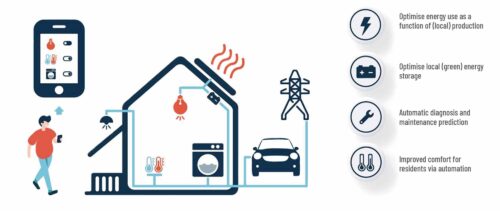Since 2018, the European “Energy Performance of Buildings Directive” has established a Smart Readiness Indicator (SRI) to assess the “smart-capability” of buildings. Next-generation buildings will be required to consume very little energy, cover the remaining energy demand from local renewable energy sources as far as possible and consume energy in line with local production. The control of these energy flows (coordinated with power grids and heating networks) will form a key element of buildings fit for the future. The SRI is intended to assess specific features and qualities of a building that are required for this kind of smart operation in a sustainable energy system. Both the requirements of the power grids and the needs of residents must be taken into account in this process.

illustration: https://energy.ec.europa.eu/topics/energy-efficiency/energy-efficient-buildings/smart-readiness-indicator/what-sri_en#sri-rating
Developing a uniform methodology
The SRI is designed to be simple, transparent and easy to understand and cheap and quick to calculate. Member states will be expected to incorporate it ideally in the energy performance certificate, initially on a voluntary basis. There are still many unanswered questions about how this indicator will actually work, and efforts are under way at both EU and national level to develop a uniform rating scheme. Experts from Austria are playing an active role on the EU’s platform for developing the SRI further and in the Europe-wide test phase, which began in 2022.1
SRI Austria
The process for devising national specifications for the SRI has already been investigated in several studies commissioned by the Federal Ministry for Climate Action, Environment, Energy, Mobility, Innovation and Technology (BMK). The experts have successfully formulated some initial proposals for a smart readiness indicator for buildings in Austria in dialogue with their European counterparts and national stakeholders.2 Various SRI approaches have also been analysed, and the “smart readiness” of buildings has been evaluated using a range of indicators.3 Another project led by AEE INTEC has recently been launched to trial smart technologies in buildings and support the SRI test phase in Austria.4 Austrian experts from AEE INTEC, the University of Natural Resources and Life Sciences, SERA global and Blueprint Energy Solutions are also working on progressing the SRI in consultation with the OIB as part of several EU-LIFE projects5 and, amongst other things, are developing an online tool for testing out the EU’s SRI methodology.
1 https://energy.ec.europa.eu/topics/energy-efficiency/energy-efficient-buildings/smart-readiness-indicator_en
2 www.nachhaltigwirtschaften.at/de/sdz/projekte/sri-austria.php
3 https://www.bmk.gv.at/themen/energie/publikationen/analytische-begleitung-SRI-testphase.html
https://www.aee-intec.at/sri-austria-analytische-begleitung-der-sri-testphase-in-oesterreich-p339
4 A national-level project entitled “SRI Demo” has been launched in May 2023 for the “Flagships for Resilient Cities 2040” support programme as part of the Climate and Energy Fund’s “Smart Cities” initiative.
5 Austrian experts are involved in three LIFE projects:
https://sri2market.eu
www.easysri.eu/en
https://srienact.eu